Salamanders are a type of amphibians. They look like lizards and they live in moist habitats or near water. They live in moist woodlands, marshes, grasslands, and other habitats under leaves and rocks.
Salamanders come in different colors such as black, yellow, and green.
They have 4 legs and a thick long tail.
Salamanders are among the rare species that can regenerate lost limbs.
A permeable skin further characterizes salamanders. They take in humidity through the skin.
Table of Contents
What are Salamanders?
Salamanders are amphibians with soft moist mucus-like skin. They live in moist habitats resembling frogs in appearance and location.
Salamanders are known to have very vivid colors not trying to mimic their environment. These vivid colors are a defensive mechanism to make predators think they’re poisonous creatures.
Salamander Identification
There are more than 600 species of salamander recognized around the world. They share characteristics such as diet and behavior.
What do Salamanders Look Like?
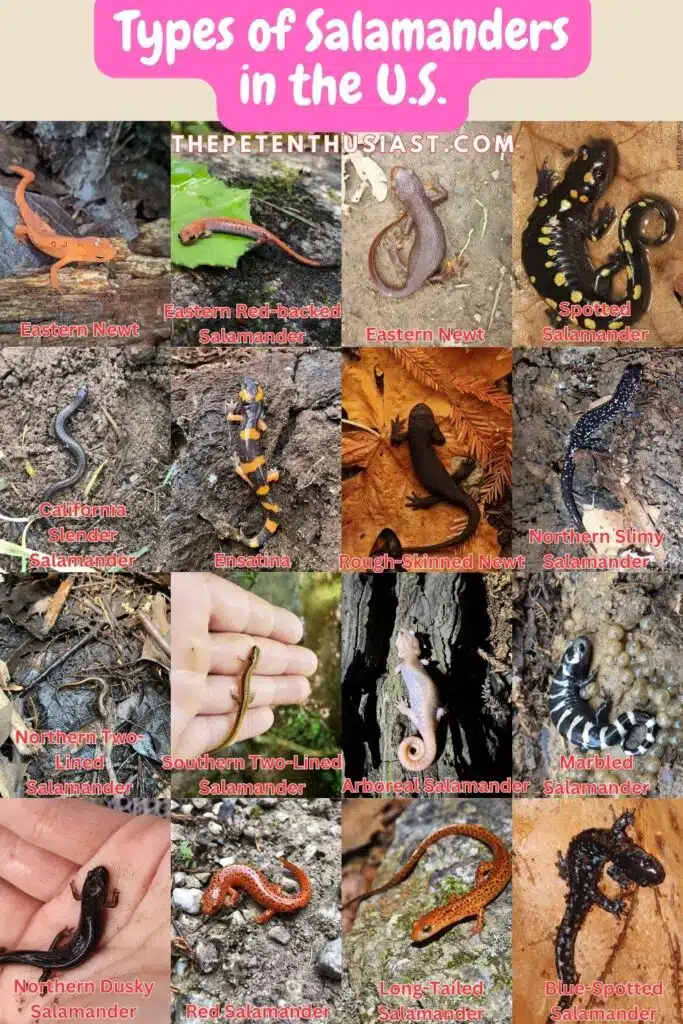
Salamanders are small amphibians that have an average size of 6 inches. They can grow larger in rare cases.
The largest recognizes salamander species is the Japanese giant salamander which grows up to a few feet.
By contrast, the Thorius arboreus is the smallest salamander. This is a tree-climbing species that rarely grows larger than 1 inch.
Diet and Behavior
The US is the country with most types of salamanders. A diverse range of salamanders lives here.
Most salamanders in the US live in forests. A smaller but still significant number of species live in caves. Both caves and woodlands share high humidity characteristics.
Habitat and Distribution
There are more than 300 salamander species in North America. They share many habits such as the ability to shed their tails in the eventuality of an attack.
Salamanders are nocturnal species only coming out during the day in cool weather to avoid dehydration.
Species of salamander in the US are mostly terrestrial with a small percentage being aquatic, mainly tied to freshwater sources.
Types of Salamanders – Identification Guide
The following species are the most common in the world of salamanders.
1. Eastern Newt
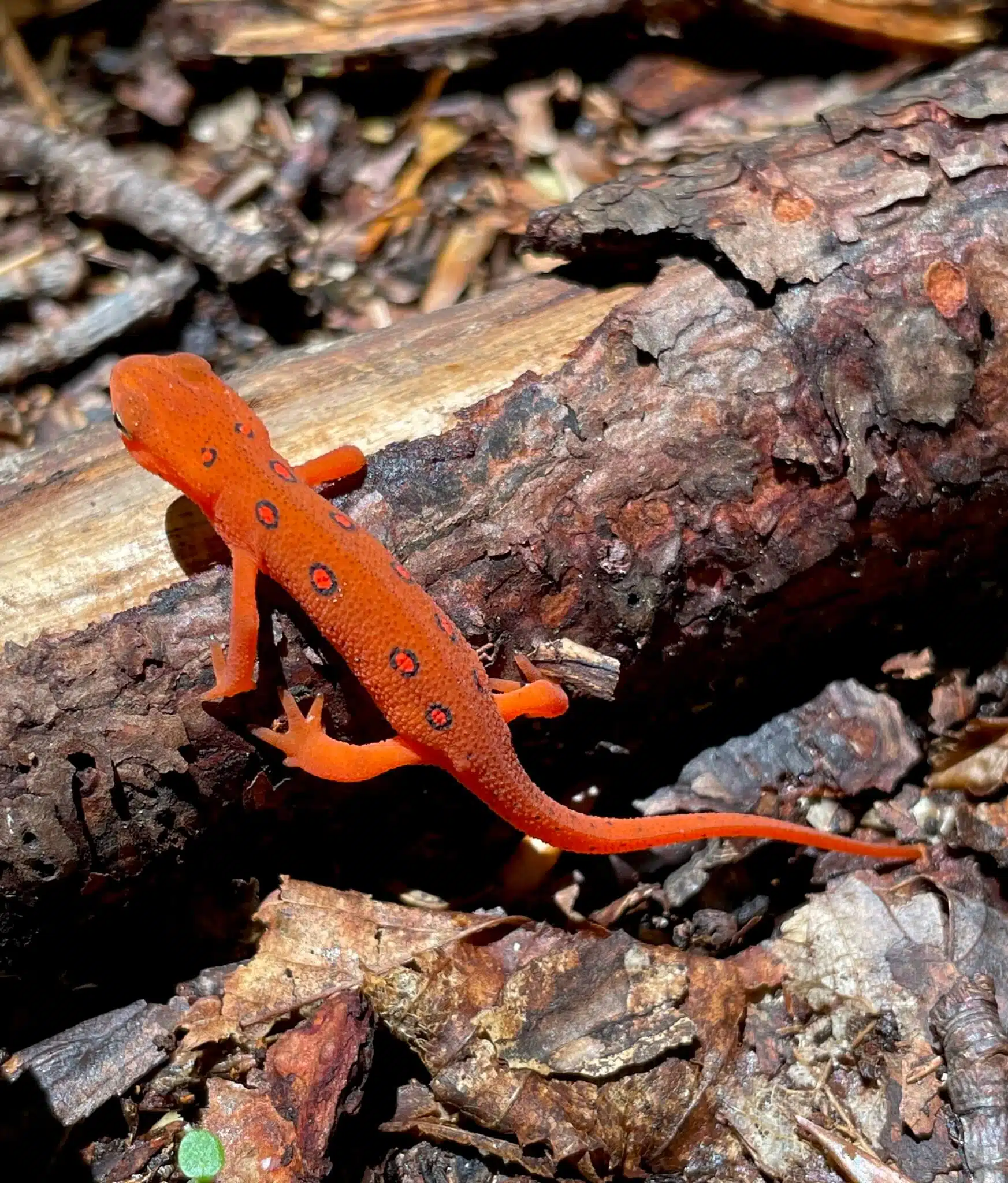
The Eastern Newt species (Notophthalmus viridescens) is common in the Eastern part of the US. Its habitat ranges from Minnesota to Maine and down to Texas.
As an adult, they are known for a striking green color dorsally and a yellow belly. As juveniles, these salamanders are orange dorsally.
They are found everywhere in muddy terrains of coniferous forests. Due to their bi-colored body, the species is also collected as pets for aquariums.
Eastern Newts eat insects, amphibians, mollusks, and even worms.
Larvae of the species are found in mud. It turns into brightly-colored efts which are warning signs as to appears toxic. Eastern Newt salamanders have a tetrodotoxin which makes them safe from predators such as fish.
While widespread, the species faces common threats such as habitat fragmentation and a low percentage of eft development.
Only 2% of Eastern Newt larvae survive to adulthood.
2. Eastern Red-backed Salamander
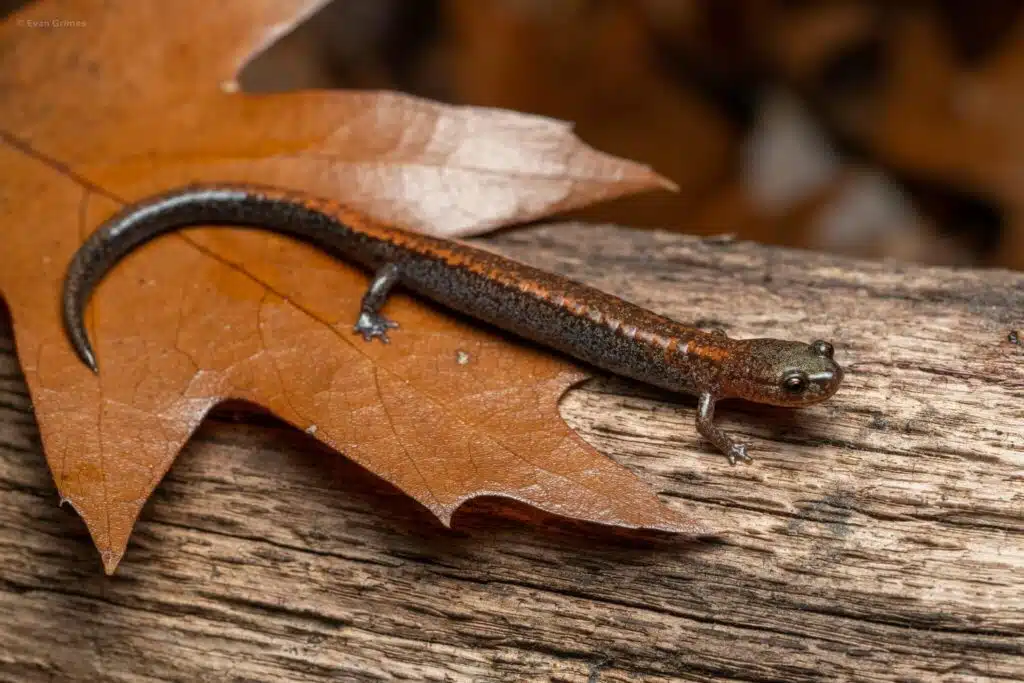
The Eastern Red-backed Salamander (Plethodon cinereus) shares its US habitat with the Eastern Newt, except for the Southeastern US states.
The species is found in 2 color variations which might make for a difficult identification. It’s seen in red color with a black dorsal stripe and a lead color darker version.
Differences in appearance within this species can have multiple causes. One of them is the presence of different temperatures as the salamander grows.
One of the distinct traits within the Eastern Red-backed salamander species is the differences in diet between the 2 morphs.
The red-backed salamander is known to have a wider diet with mites topping its list of preferences.
A reduced diet mostly comprised of ants and mites characterizes the preferences of the lead version of salamander.
3. California Newt
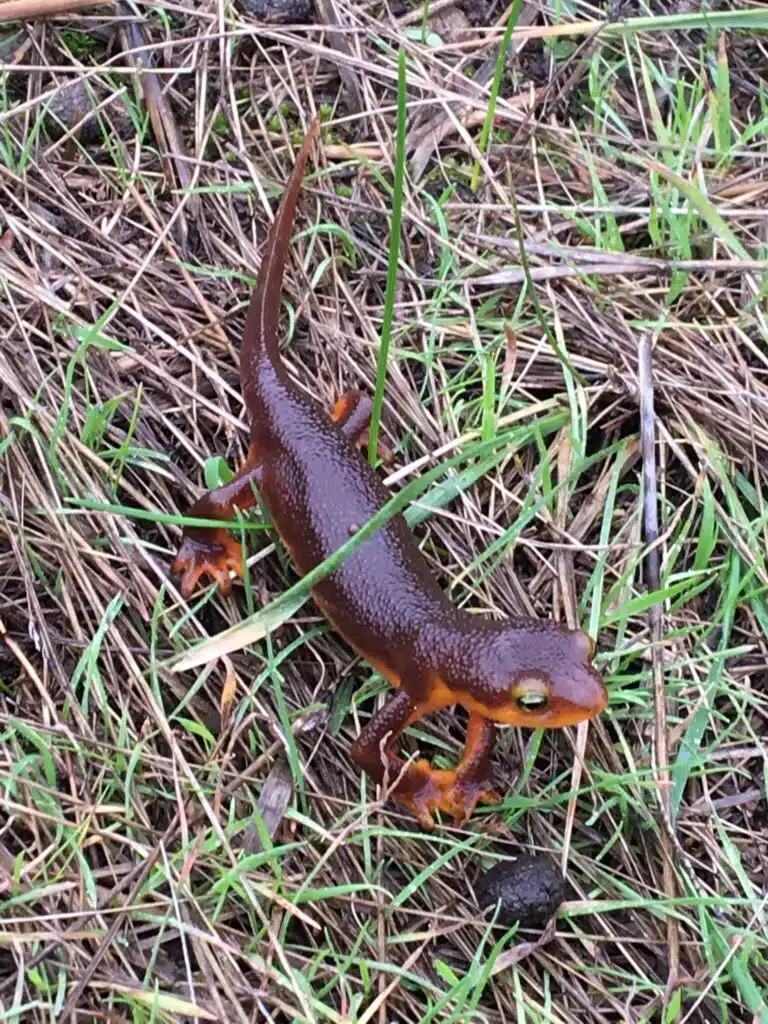
The California Newt (Taricha torosa) is a species of salamander native to California. It grows up to 8 inches and it can be found in Southern parts of the state’s coastal streams.
Its habitat is now diminished due to the prevalence of predators such as mosquitofish as well as Garter snakes.
These salamanders produce a skin toxin that limits the number of predators that would eat them.
Common in Southern parts of California and the Sierra Nevada, this species is interested in consuming worms, slugs, crickets, and eggs such as fish eggs.
Seeing this salamander in its natural habitat is common. It resides next to small ponds. It finds its food here and its predators here as its larvae are targeted by fish.
4. Spotted Salamander
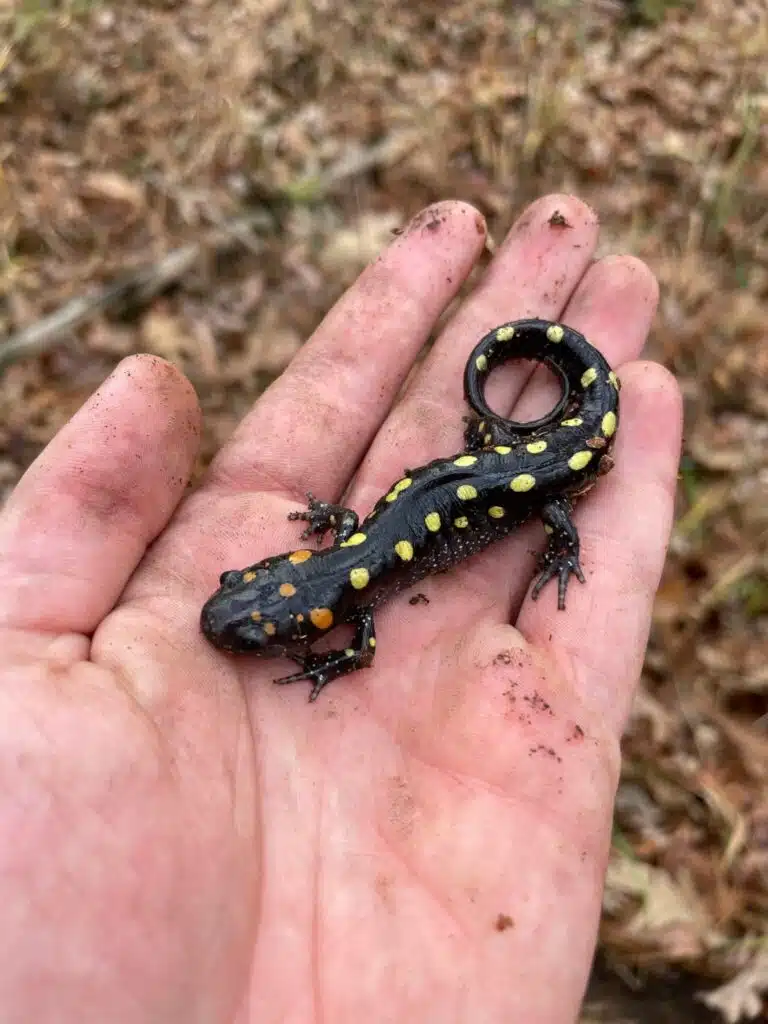
The Spotted Salamander (Ambystoma maculatum) is considered large when compared to other US species as it grows to almost 10 inches.
Salamanders of the species are mostly seen in black coloring with orange or brown spots along their body.
Preferred habitats include swamps and forests, particularly at higher altitudes. This salamander is also present in Eastern parts of the country but not seen in coastal areas.
The species is not easy to see as its nocturnal. Furthermore, people rarely see it as it lives in remote areas where it’s even active during the winter.
Salamanders of this species are known to guide themselves after wintertime rains to move towards ponds where they need to lay eggs in the spring.
Up to 200 eggs are laid in ponds by this species. Only a handful of these survives into adulthood.
5. California Slender Salamander
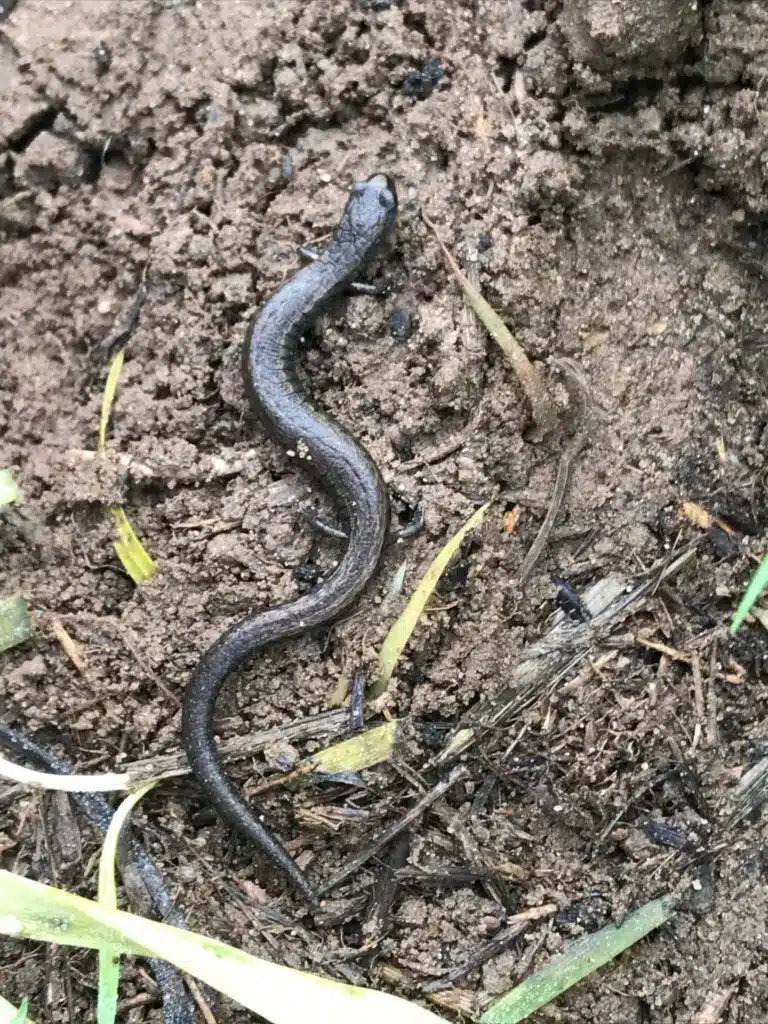
This species (Batrachoseps attenuatus) is found across California. It’s known for its dark body with yellow or brown stripes.
Adapted to living next to water sources, the species is tied to redwood forests and California oak woodlands.
It lives in these habitats next to freshwater streams or ponds.
The species is of medium size and known for its agility.
California Slender salamander is known for eating termites and worms. It digs in burrows and finds its favorite prey.
The species is sometimes looking for existing burrows and underground nests for shelter. It needs moisture and a cool place to hide from the warmest periods of the day.
6. Ensatina
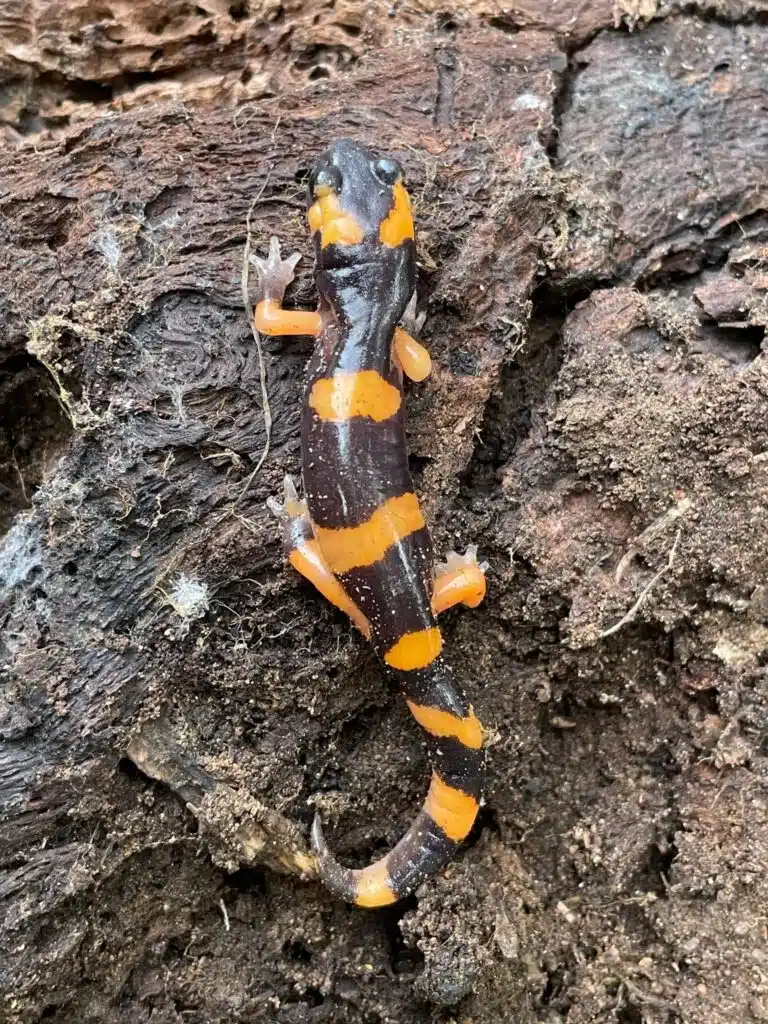
Ensatina salamander (Ensatina eschscholtzii) is found in the Western regions of the US and California. It has a common presence from British Colombia down to California where it lives and lays eggs underground.
The species is known for its dark brown body with a few pink dorsal marks.
Some of the places where the species is easiest to spot include habitats next to water sources.
Like another salamander, it should not be handled roughly as it breathes through its skin.
The species is not dangerous to humans but it resents being handled as it can eliminate a milk-like secretion when handled.
7. Rough-skinned Newt
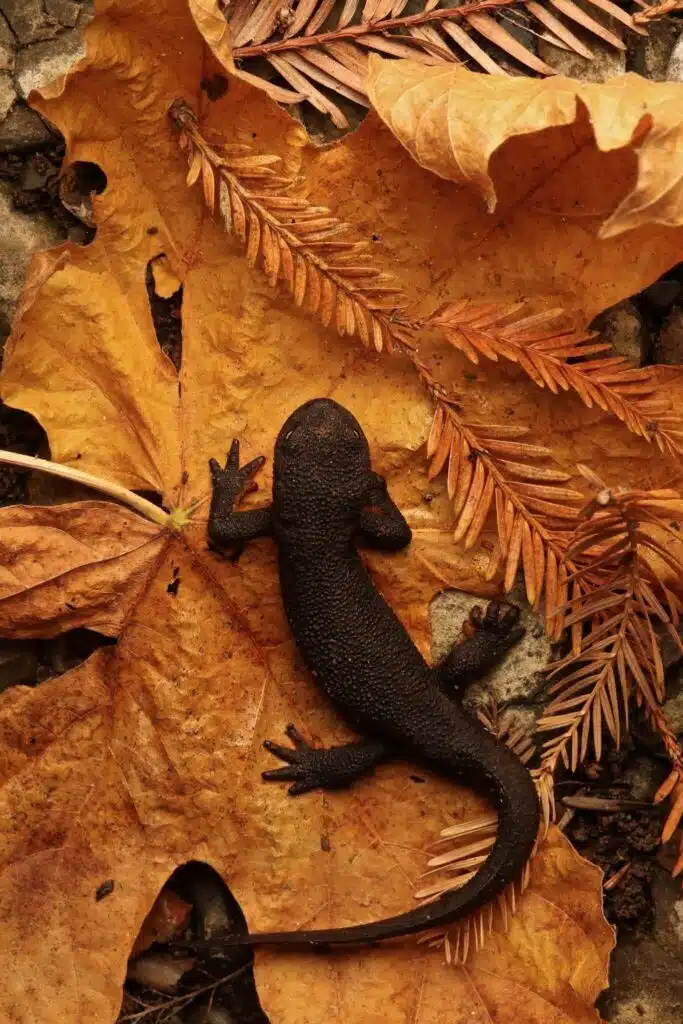
The species of Rough-skinned Newt (Taricha granulosa) is known for its thick dark brown to black body.
It has a growing habitat in the Western part of the country. Reported populations include areas of Alaska, Idaho, and California.
Rough-skinned Newt salamanders are some of the most toxic in California. Their skin regularly irritates when handled.
The species is also known for having an off-putting scent. Some people have described this scent as highly acidic.
This scent is used for self-defense. Rough-skinned Newt salamander has to stay away from its most common predator, the Common Garter snake.
8. Northern Slimy Salamander
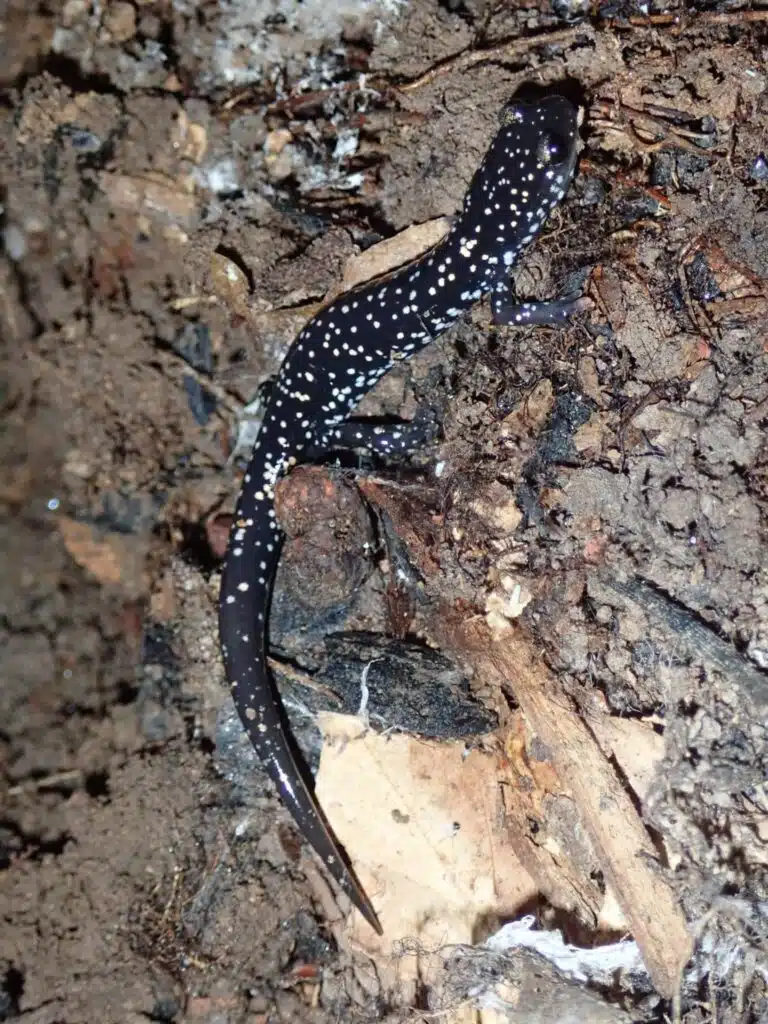
The Northern Slimy Salamander (Plethodon glutinosus) is found in New York, Mississippi, New Hampshire, and Alabama. This species is mostly black with a few light marks across its body.
Salamanders of this genus get their name from the slime they produce through their skin. This is a sticky substance used to keep potential predators away.
Like most other salamanders, the Northern Slimy salamander prefers moist soils and it moves under leaves most of the time.
This is also the ideal territory to find ants and beetles.
9. Northern Two-lined Salamander
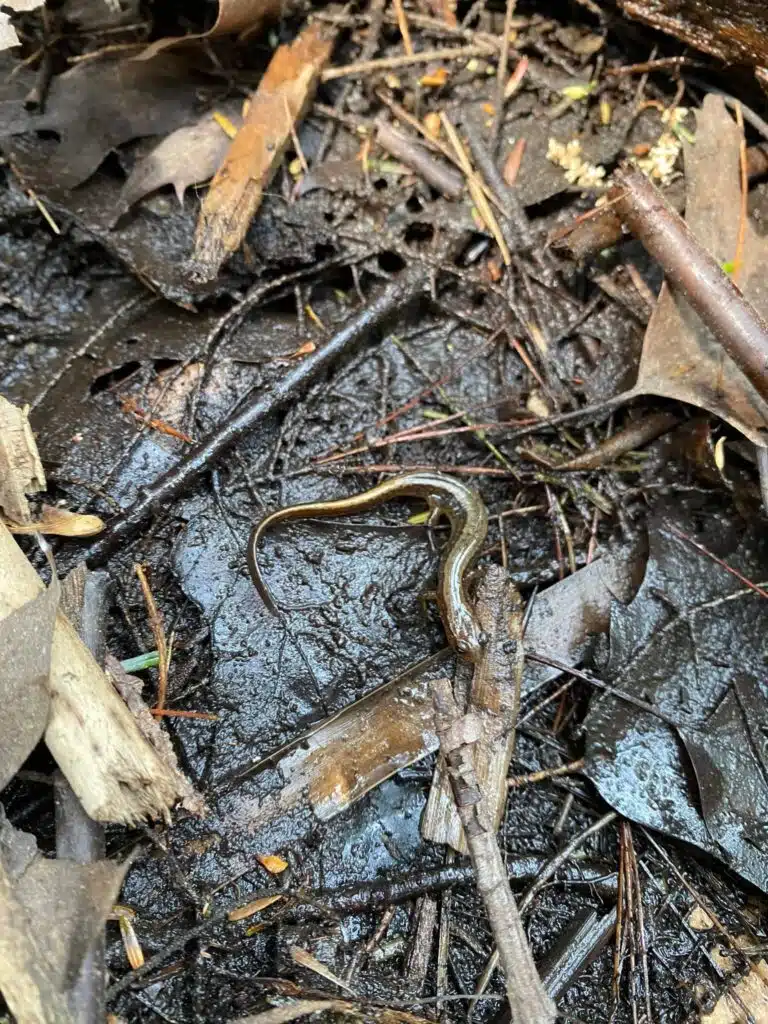
The Northern Two-lined Salamander (Eurycea bislineata) gets its name from the 2 lines that run from head to tail and make this species distinctive.
Salamanders of this genus are known to be small. They may grow up to 120mm in adulthood.
As their name implies, these salamanders are mostly found in Northeastern territories of the US as well as in Canada.
The salamanders of the genus are known to prefer rocky rivers where they’re often seen looking for food.
Characteristic reduced dimensions of the species also make it one of the vulnerable types of salamander in the Northeast. Birds, owls, and snakes are among its most common predators.
10. Southern Two-lined Salamander
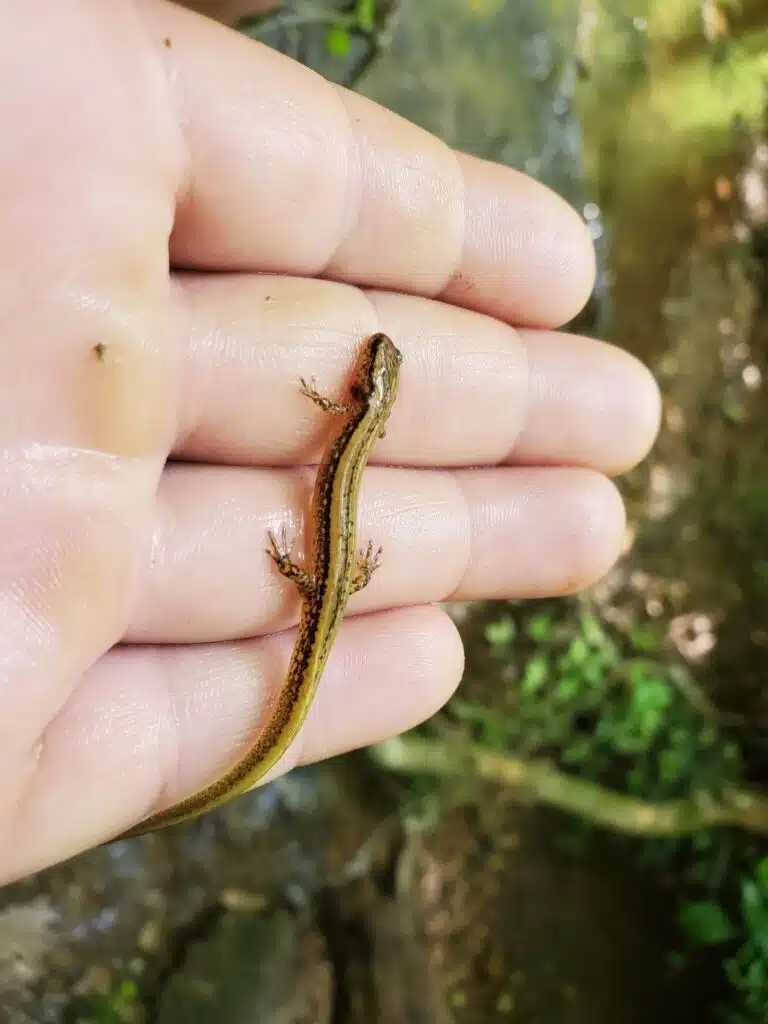
Known for the lines that run from head to tail, this tan-brown salamander (Eurycea cirrigera) is common and not threatened.
It has a high presence in Southeastern states except for Florida.
Salamanders of this genus grow to a size between 2.5 and 7.5 inches. They are found next to water sources.
Its larvae are aquatic and often seen around streams and creeks.
Females lay eggs on the substrate and they prefer to do this as a means of protection.
11. Arboreal Salamander
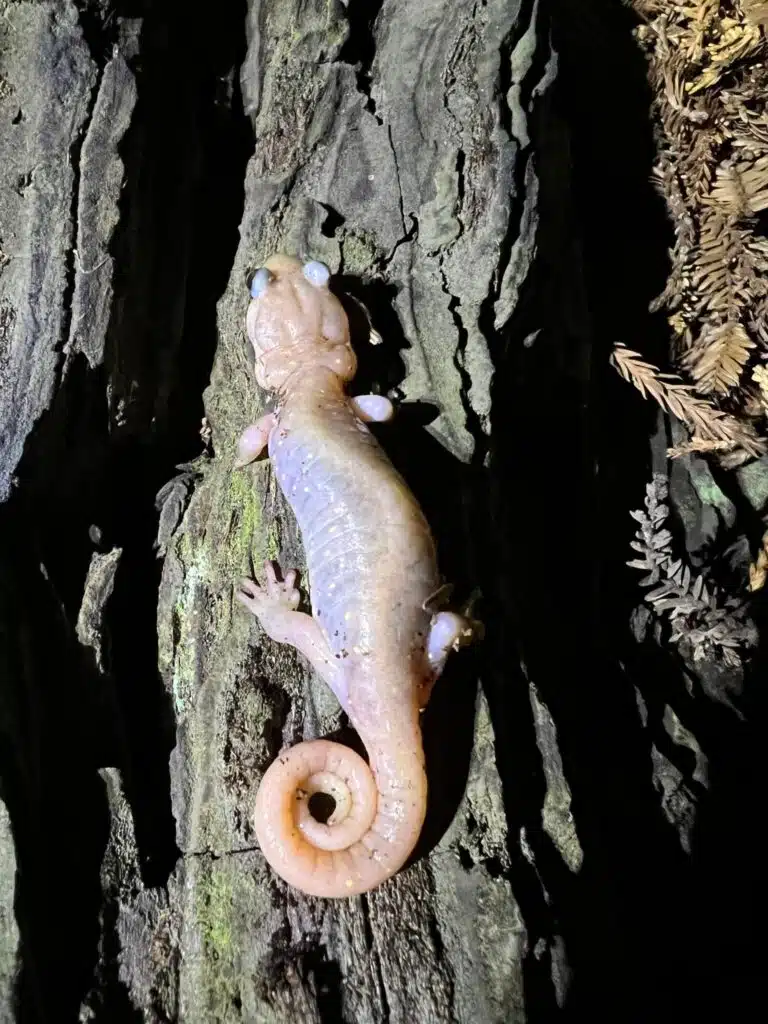
This species of salamander (Aneides lugubris) has a purple-brown color. It’s rarely seen by people as it’s a nocturnal species that climb trees.
It has excellent climbing abilities and its reduced body size helps it climb trees to the top.
This species only grows to a maximum size of up to 3.5 inches.
The Arboreal salamander doesn’t make for a good pet as it can bite inflicting pain. The species is also known for making a faint sound.
Sounds made by the Arboreal salamander are often compared with barking dogs.
12. Marbled Salamander
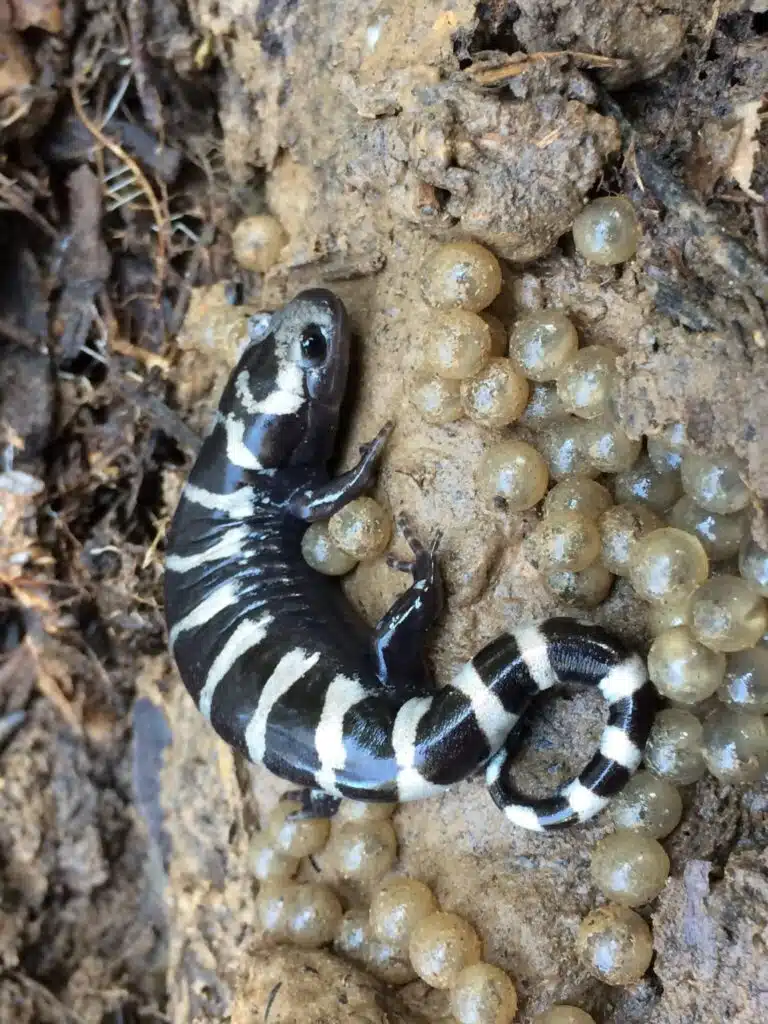
The Marbled Salamander (Ambystoma opacum) gets its name from the white marks on its black body. This is a unique species encountered in the Southeast, mainly due to its reproductive habits.
The Marbled salamander lays eggs in the fall until late October while most other salamanders lay eggs in the winter.
This is also the only time when people can see these salamanders getting out of the ground.
Females use the rain of the fall to travel toward water sources in high humidity. They remain with the eggs (up to a few hundred) until rain falls again prompting them to hatch.
In some years, there’s no rain during the fall. Eggs have to wait for the water of the rain to hatch, but only in the spring in this case.
Salamanders of these species are known to be toxic, they should not be handled.
13. Northern Dusky Salamander
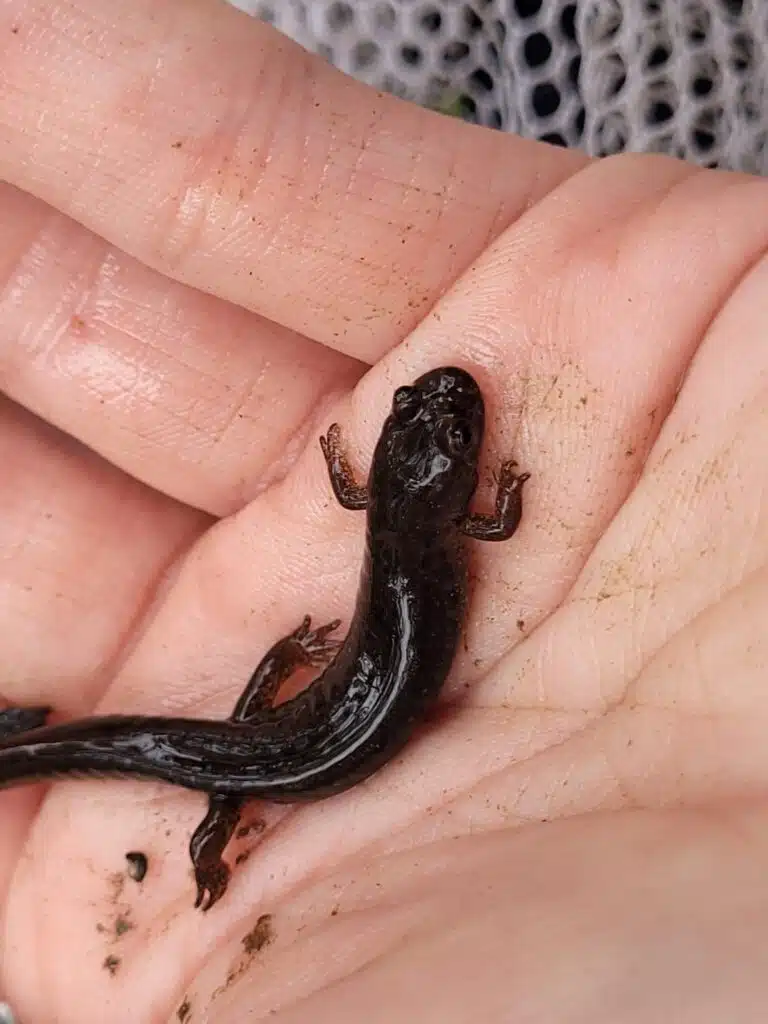
Northern Dusky Salamanders (Desmognathus fuscus) are found in Northeastern parts of North America. The species has a few distinctive traits such as a shiny brown body and low mobility.
The species can be seen in upland streams, far from suburban areas and crops.
Salamanders of the species are known for having one of the most varied diets in the Plethodontidae family.
These salamanders eat all types of invertebrates found around streams and rivers.
Northern Dusky salamanders are known to live long lives. They can survive up to 15 years.
These salamanders only reach a mating age of 3 to 4 years. Their mating process is characterized by short periods of courtship.
14. Red Salamander
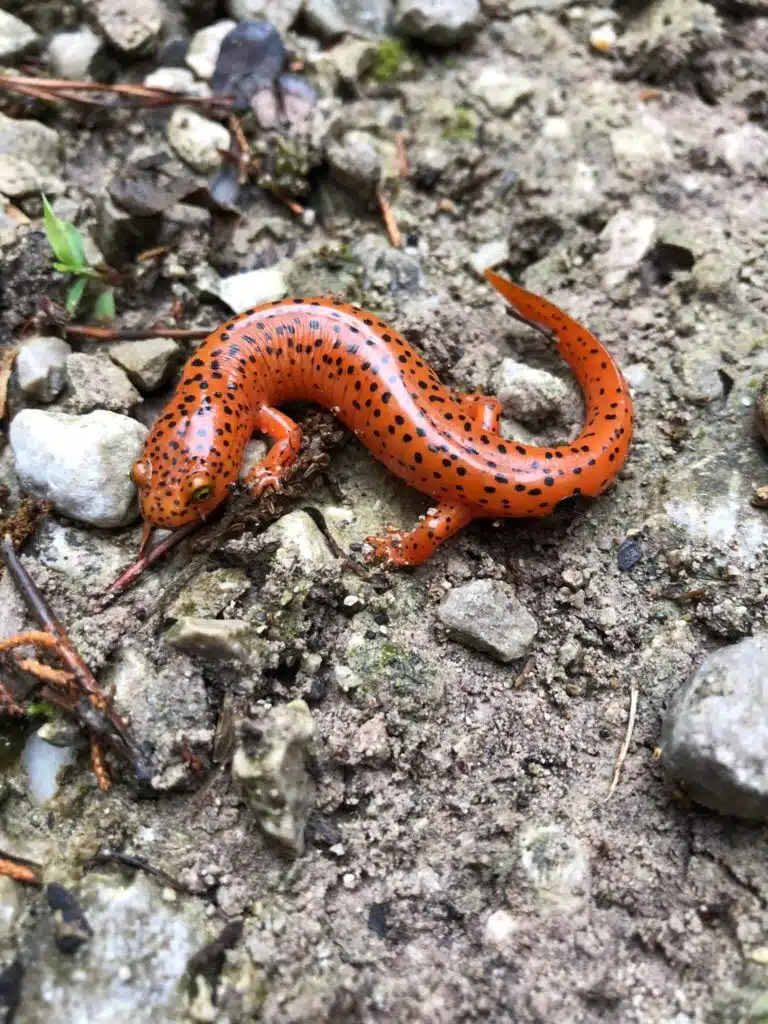
Red Salamanders (Pseudotriton ruber) are found in forests, ponds, and shrubland in Eastern US. The species is characterized by a bright red body with small black spots.
Salamanders of the genus grow to 7.1 inches and they are known for having an expanding habitat with a few exceptions such as in Indiana when it has an endangered status due to habitat fragmentation.
Like other salamanders, the Red salamander breathes through its skin. It also eats the same invertebrates as other salamanders.
Red salamanders are known for eating insects. They also eat earthworms, but only when they reach adulthood as they are larger than some insects young salamanders eat.
Spiders and crustaceans are also eaten by adult Red salamanders.
15. Long-tailed Salamander
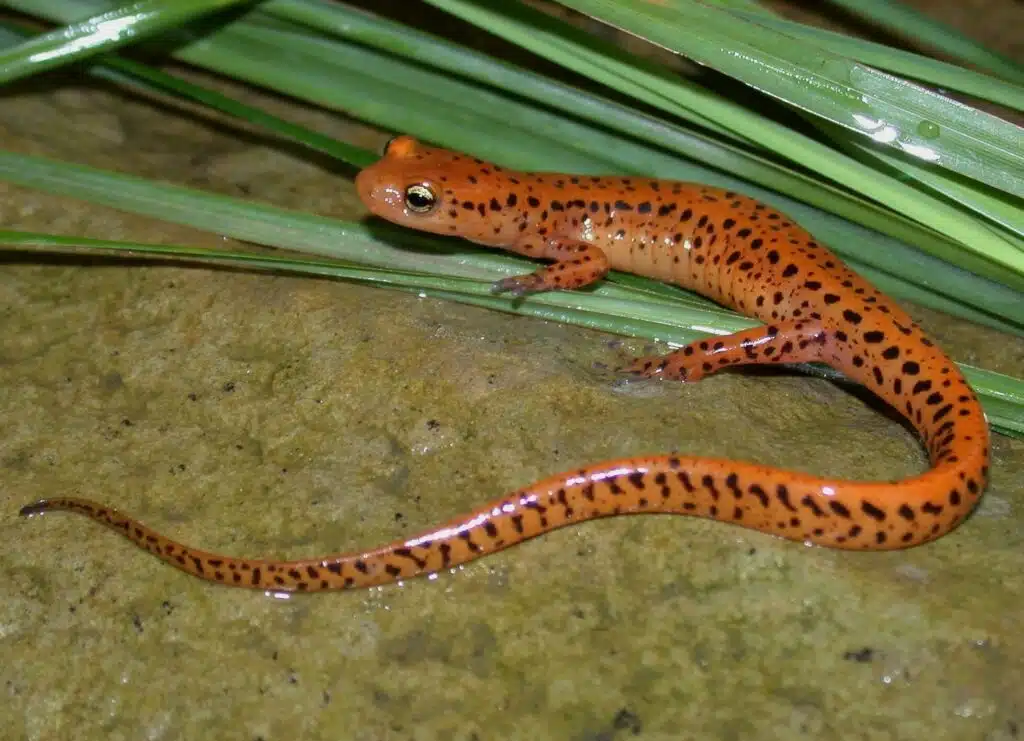
The Long-tailed Salamander (Eurycea longicauda) is a species that has an orange or orange-brown coloring with black dots.
Its tail makes up more than half of its body length. These salamanders can grow up to 8 inches.
They are found in Eastern parts of the country next to water sources such as streams, rivers, and ponds.
Seeing these salamanders is easy since they tend to congregate. Up to a few hundred Long-tailed salamanders can be found in the same place.
This is typically a shaded place as they like to stay away from the sun during the day, only coming out in the evening.
16. Blue-spotted Salamander
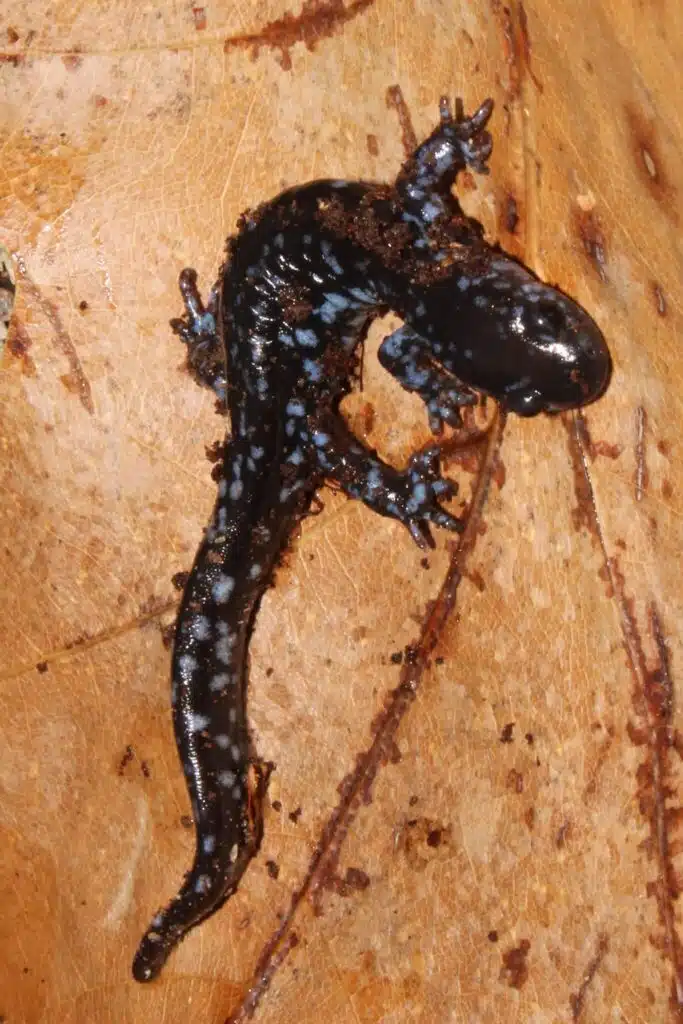
Blue-spotted Salamanders (Ambystoma laterale) are a growing species with a common presence in the Northeastern parts of the US.
As its name suggests, the coloring of this species has blue undertones. Known for its black color with blue undertones, the species stands out in its natural habitat which includes ponds with thick vegetation.
These salamanders are also seen in forests. Coniferous forests tend to attract them the most.
As these salamanders grow, they move further inland from the ponds they hatch in.
The Blue-spotted Salamander is one of the most prolific breeders in temperate climates as females are known to lay up to 300 eggs per year.
17. Northwestern Salamander
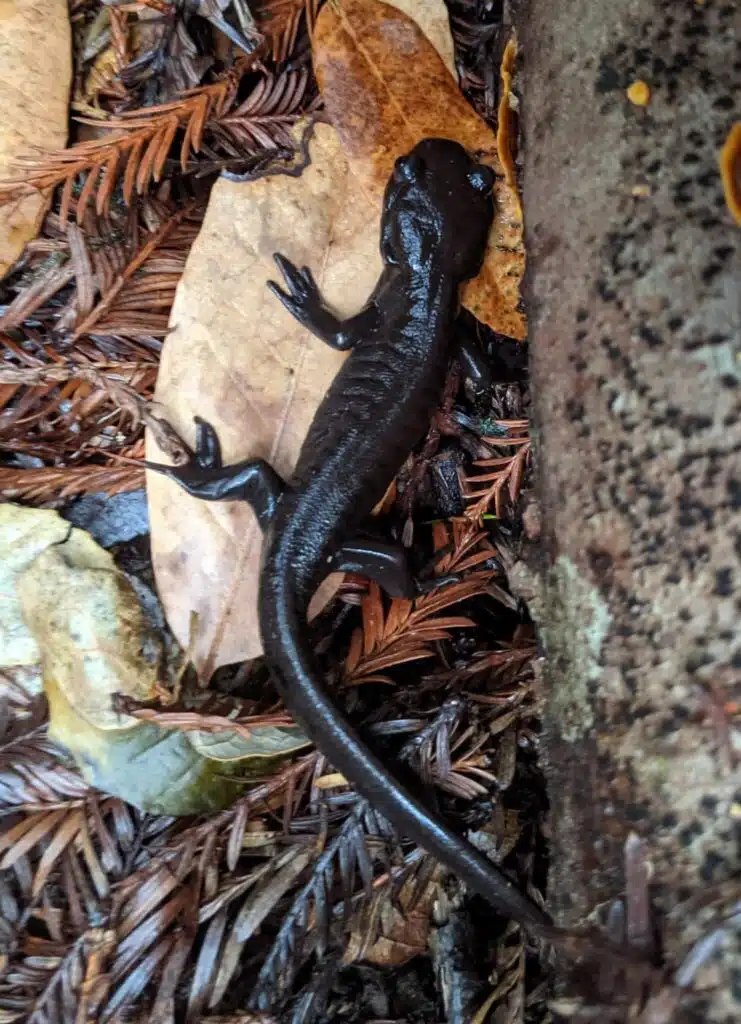
Northwestern Salamanders (Ambystoma gracile) have a tan to brand coloring with or without black marks. Climate is believed to influence the presence of black marks on some Northwestern salamanders.
The species becomes more common at a higher altitude compared to lower grasslands.
Known as terrestrial species, these salamanders are often seen coming out with the rain when they move towards water sources to lay eggs.
Their eggs measure around 2mm in diameter and they’re always found in areas with water.
Salamanders of the genus are also known to have the ability to dig through mud and loose soil.
This is why adults of the species are rarely seen during the warm summer days when they prefer to be underground in a cooler location.
18. Allegheny Mountain Dusky Salamander
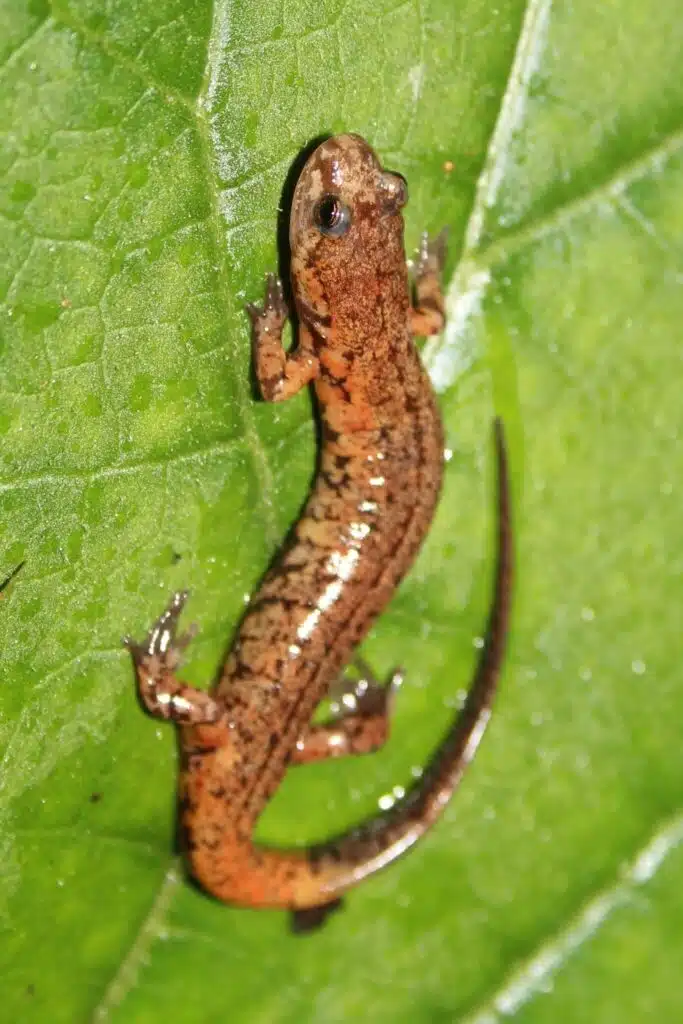
Salamanders of this genus (Desmognathus ochrophaeus) are found in Eastern parts of the US. They come in different colors, but mostly in various shades of brown.
These salamanders also have a line that runs along their dorsal which can be black, yellow, brown, or black.
Preferred habitats include streams and ponds. While the Eastern part of the US also has larger streams and rivers, the species prefer to stay away from them due to the presence of predatory fish.
Adults of the species are also found in rocky areas. They are mostly enticed by living under large rocks. Most of these preferred rocky areas are found within woodlands.
19. Black-bellied Slender Salamander
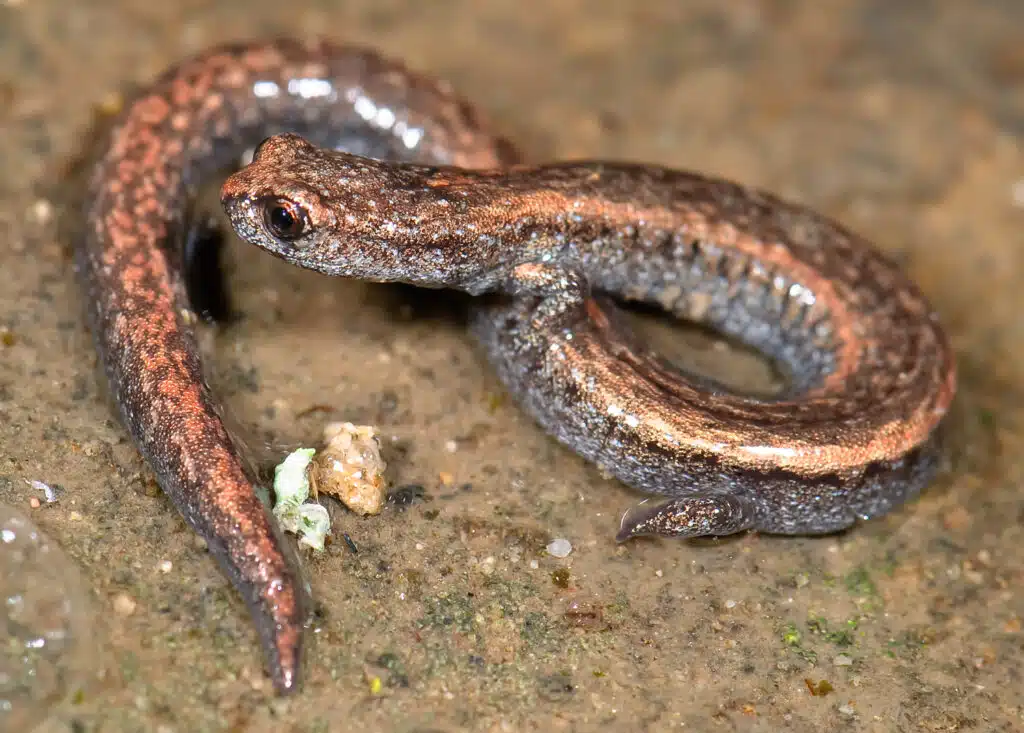
This species (Batrachoseps nigriventris) is native to California. It lives in the California chaparral and woodlands.
Black-bellied slender salamanders have a brown, black, or reddish color. These are among the salamander species that don’t look like salamanders.
Resembling earthworms, these salamanders are often overlooked by many as simple worms.
This resembles worms also makes them slower in movement and a bigger target for potential predators.
Salamanders of the genus are also very fragile and may not survive handling.
20. Coastal Giant Salamander
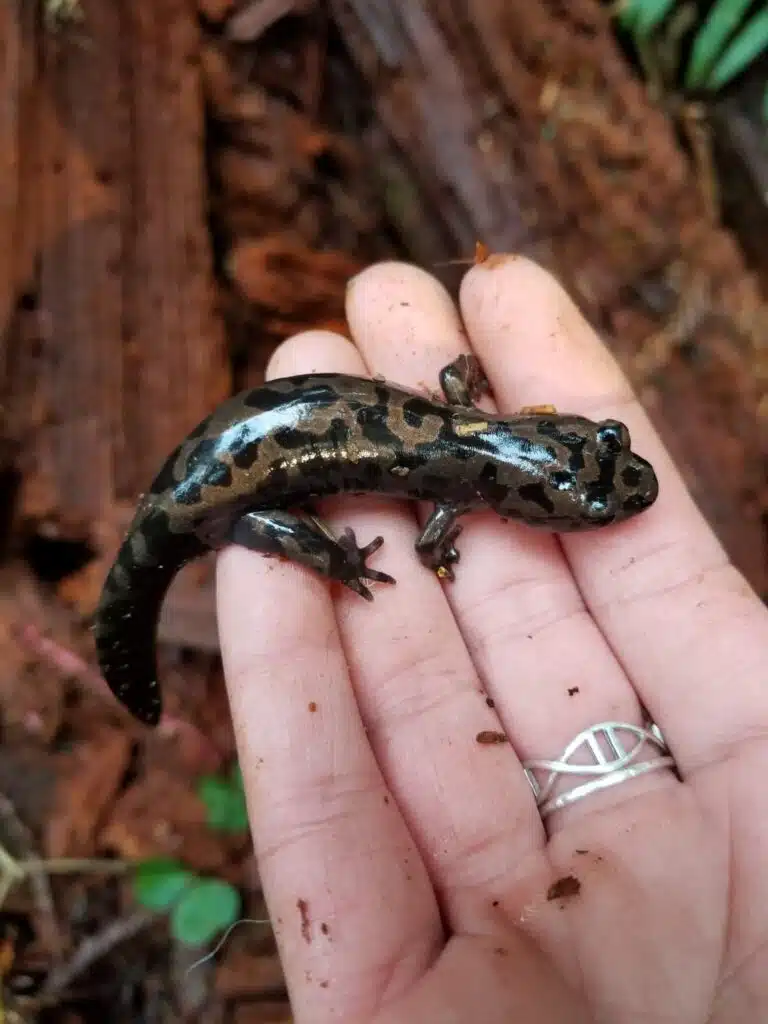
The Coastal Giant Salamander (Dicamptodon tenebrosus) is the largest species of salamander in the US. It grows up to 13 inches and it’s found in the Pacific Northwest.
The Coastal Giant salamander has a long tail that represents up to 40% of its body.
It eats worms, small fish, and slugs.
Identified by its black and brown body, this species is also highly toxic.
While not life-threatening, it should still not be handled as it can release a headache-inducing toxin through its skin.
These salamanders eat a range of bacteria that aid the production of these toxins.
As giant salamanders, they also have larger predators. Other defensive mechanisms outside their toxins include taking up a defensive position where it raises its tail upward and forward.
21. Long-toed Salamander
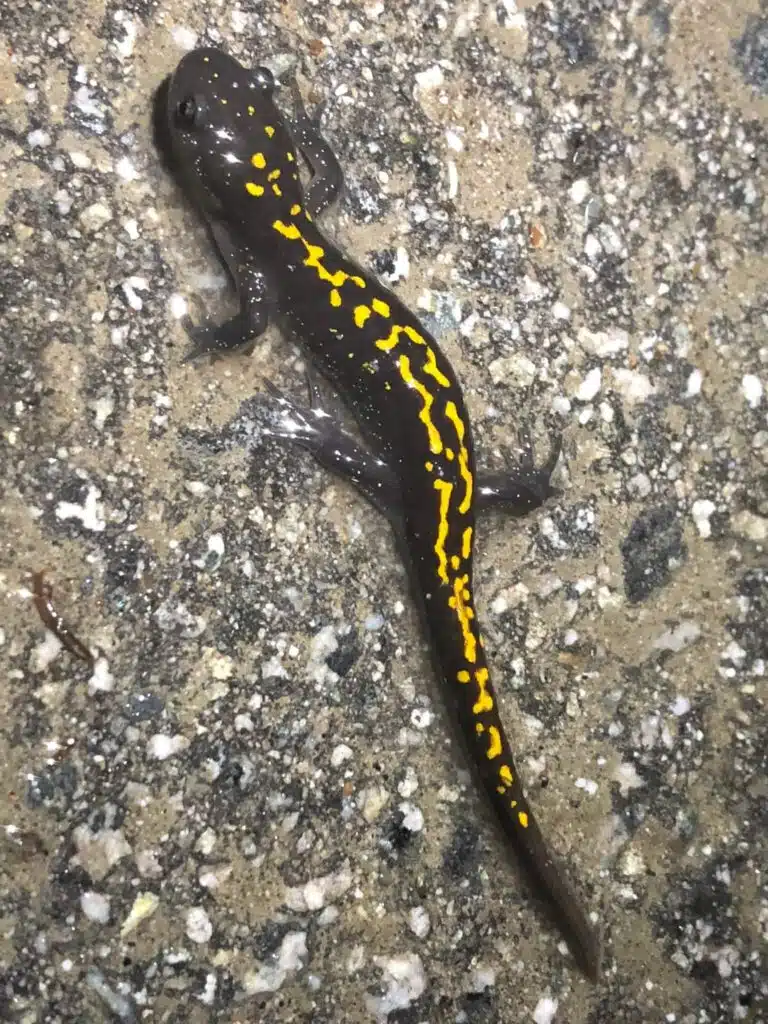
The Long-toed Salamander (Ambystoma macrodactylum) is the second most widespread salamander species in the US. It lives throughout the Pacific Northwest where it lives in highlands and alpine meadows.
Salamanders of this species are rather short, only growing to a size between 2 and 3.5 inches.
It lives at high altitudes and rarely at low altitudes where it remains active throughout the year.
Rarely seen by people due to its secretive nature, this species is known to overwinter in the ground, below the surface, and in freezing temperatures.
Clusters of Long-toed salamanders are known to overwinter together.
One of the adaptions that allow the species to hide in the ground for months is its capacity to store protein.
It uses stored protein reserves around its body and in its tail as food during the winter when it lives with up to 25 other salamanders of the species in the ground.
22. Seal Salamander
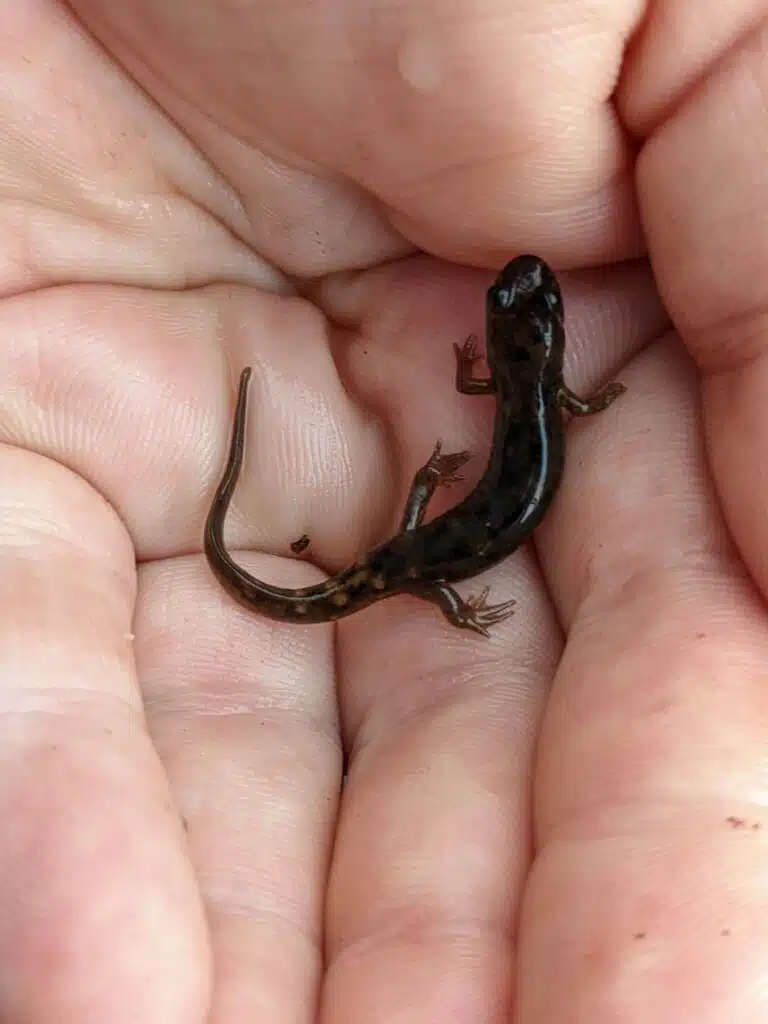
The Seal Salamander (Desmognathus monticola) is found in many hardwood forests. It prefers small forest streams as its habitat and this is also where the females lay their eggs.
Female Seal salamanders lay a small number of eggs compared to the average species in North America. They can lay up to 30 eggs per year.
Even with a small number of laid eggs, the species remain abundant.
It achieves an abundant status through the toxins it uses in self-defense. Only snakes dare to attack the Seal salamander as a result.
Furthermore, adult Seal salamander often hides in narrow crevices during the day. These remote areas are difficult for predators to get into.
23. Cave Salamander
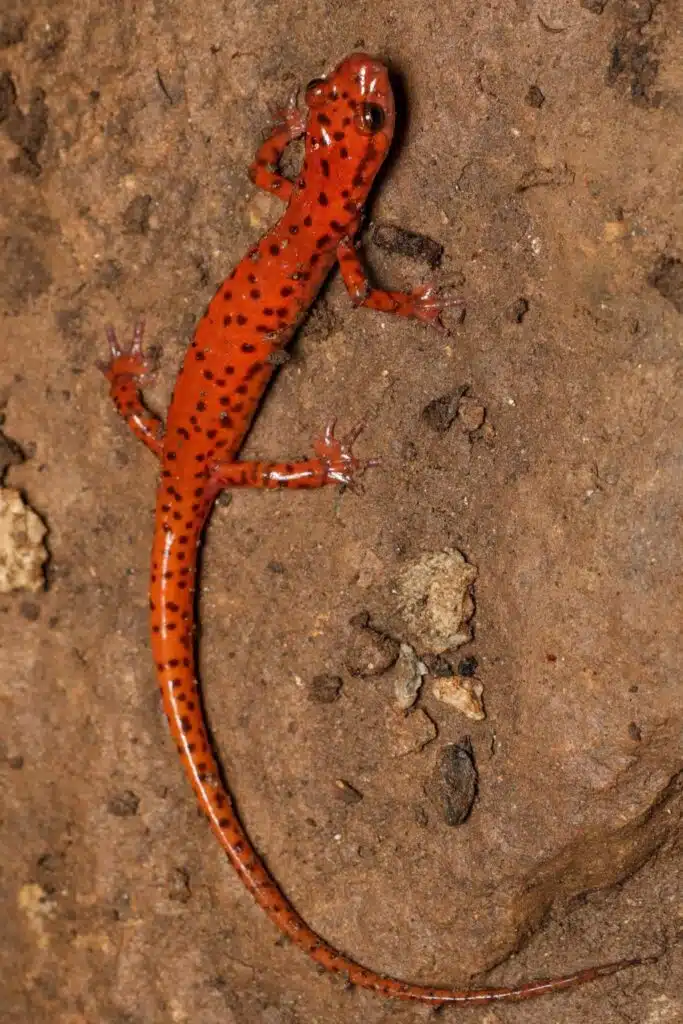
This species (Eurycea lucifuga) is native to the US. As its name suggests it lives in caves or near caves. It may travel up to a few hundred yards away from caves.
Over time, subspecies of the Cave salamander have been noted in forests and habitats with no caves at all. These include habitats in Ohio, Kentucky, and Virginia.
Cave salamanders are known for their bright orange or yellow body with black spots on the dorsal side. These salamanders are also known to be mid-size or large-size.
These salamanders have secretive lives and secretive reproduction rituals. While their reproductive habits are already known, their eggs are rarely found.
This indicates Cave salamander might lay eggs inside caves, crevices, underground, or in other very remote locations.
It’s believed that female Cave salamanders lay eggs over time for a few months from September to February.
24. Barred Tiger Salamander
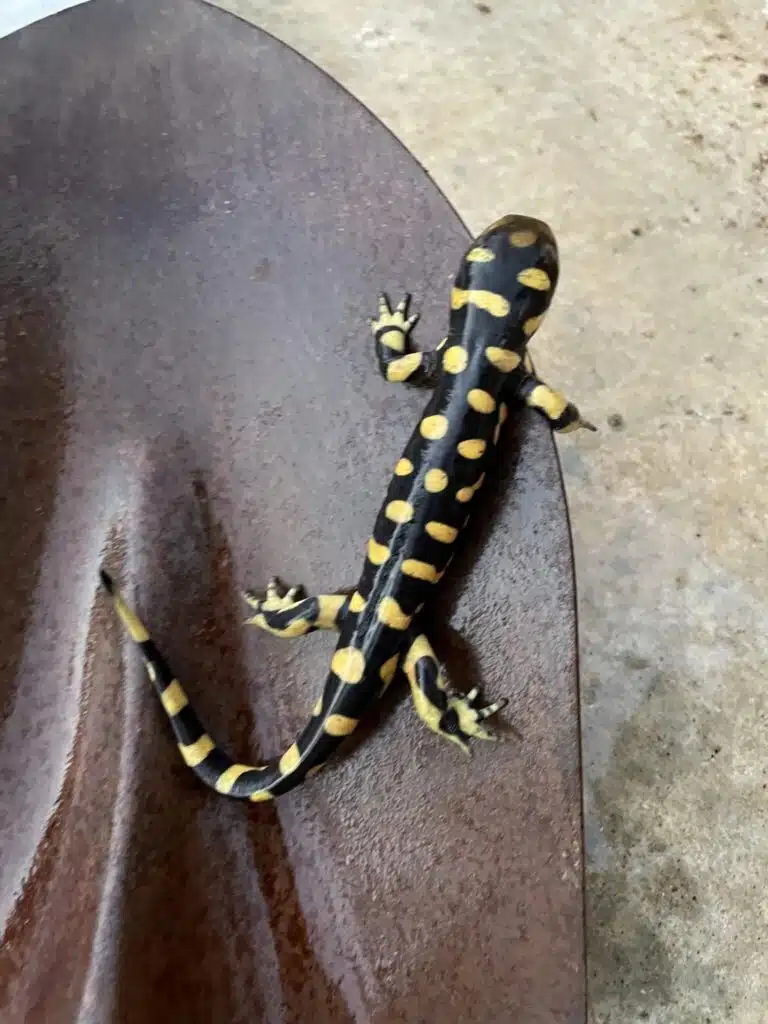
The Barred Tiger Salamander (Ambystoma mavortium) is a species that closely resembles tigers. It has a dual color stripped body which inspires its name.
Barred Tigers are also some of the largest salamanders found in the US. They grow more than 10 inches in length and this also makes them good pets, even if trading them has now become illegal in many parts of the country.
These salamanders are known for resembling tigers, but they also show other distinct characteristics such as cannibalism.
Research shows that this species of salamander will still look towards cannibalism even in the case of food abundance.
Otherwise, the species is opportunistic and it will fee on almost any type of insect or animal it can ambush.
25. Spring Salamander
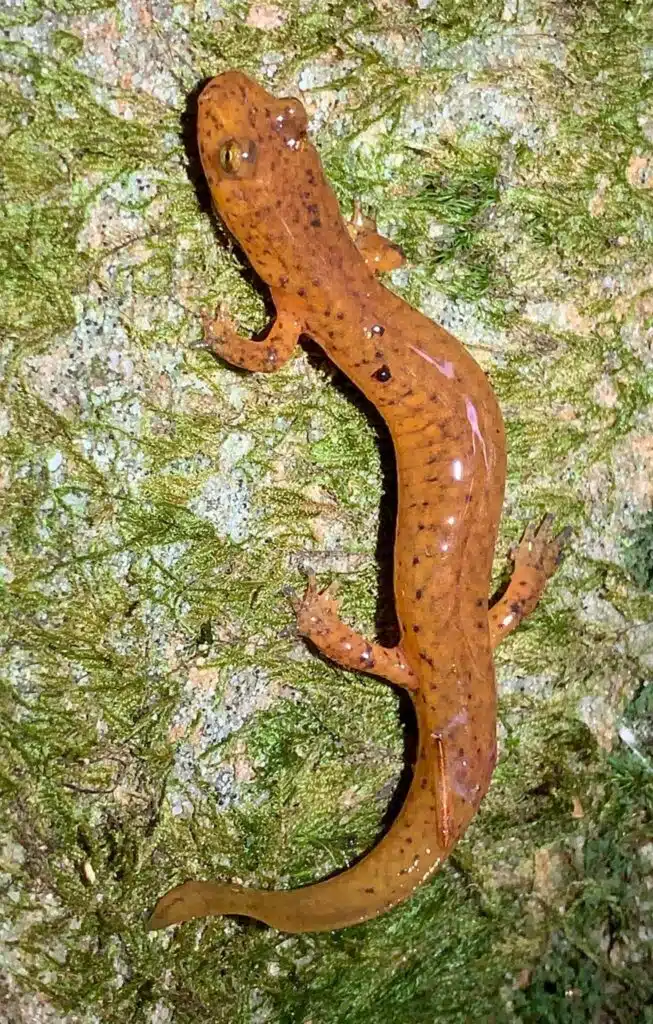
The Spring Salamander species (Gyrinophilus porphyriticus) is also known as the Purple salamander. Its physical appearance is dominated by a uniform purple color.
Like most other salamanders in the US, it can be found in the Eastern parts of the country with a high presence in the Eastern parts of Canada as well.
The species grows to a maximum size of up to 7.5 inches. It can be seen occasionally alongside streams in forests in a temperate climate.
Salamander of this genus prefers cold streams. This is why its preferred habitat is always upstream at higher altitudes where temperatures are lower.
26. Four-toed Salamander
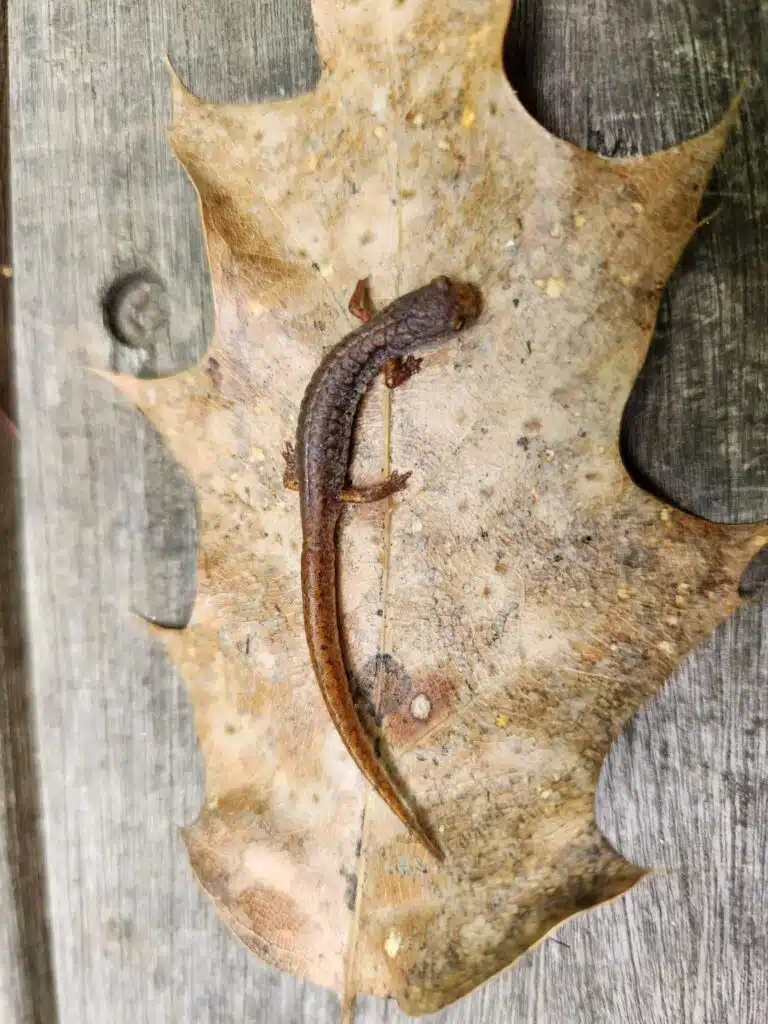
Four-toed Salamanders (Hemidactylium scutatum) have a red-brown color. They grow to a size between 2 and 4 inches and they are scarcely found around Eastern US territories.
Unlike other salamander species in this part of the country, the Four-toed salamander only lives under the leaves of hardwood forests. It prefers this habitat to other types of forests and riparian areas.
The female salamander is known to lay eggs in vegetation around the water or in the water in these woodlands.
One of the distinct traits of the females of these species is their capacity to defend eggs. Many females are seen patrolling the area with the eggs, oftentimes in small groups.
27. California Giant Salamander
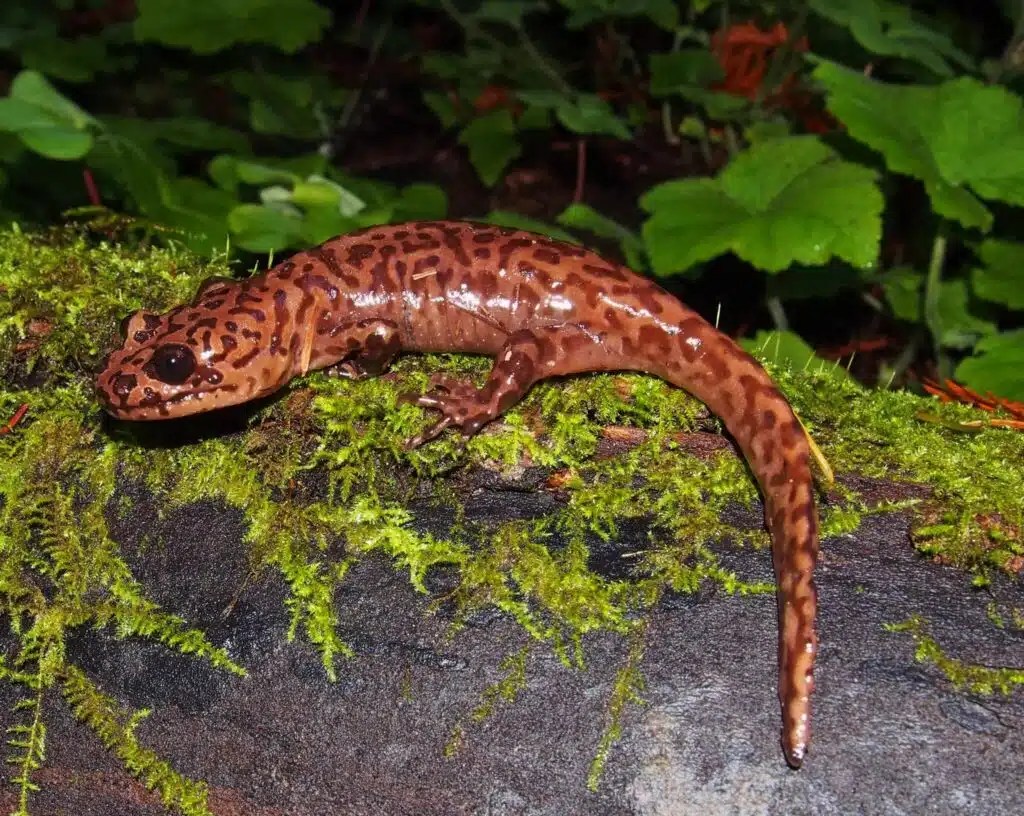
The California Giant Salamander (Dicamptodon ensatus) is one of the largest salamander species in North America.
It grows to a maximum size between 6.5 and 12 inches and it’s identified by a brown color with dark brown or black marks on its tail, body, head, and legs.
These salamanders are known to live at different elevations up to 6.500 feet.
Apart from their large size, they’re also known as types of salamander that guard their eggs.
Unlike in other salamander species, it’s the male California Giant salamander that guards the eggs once laid by the female.
28. Western Red-backed Salamander
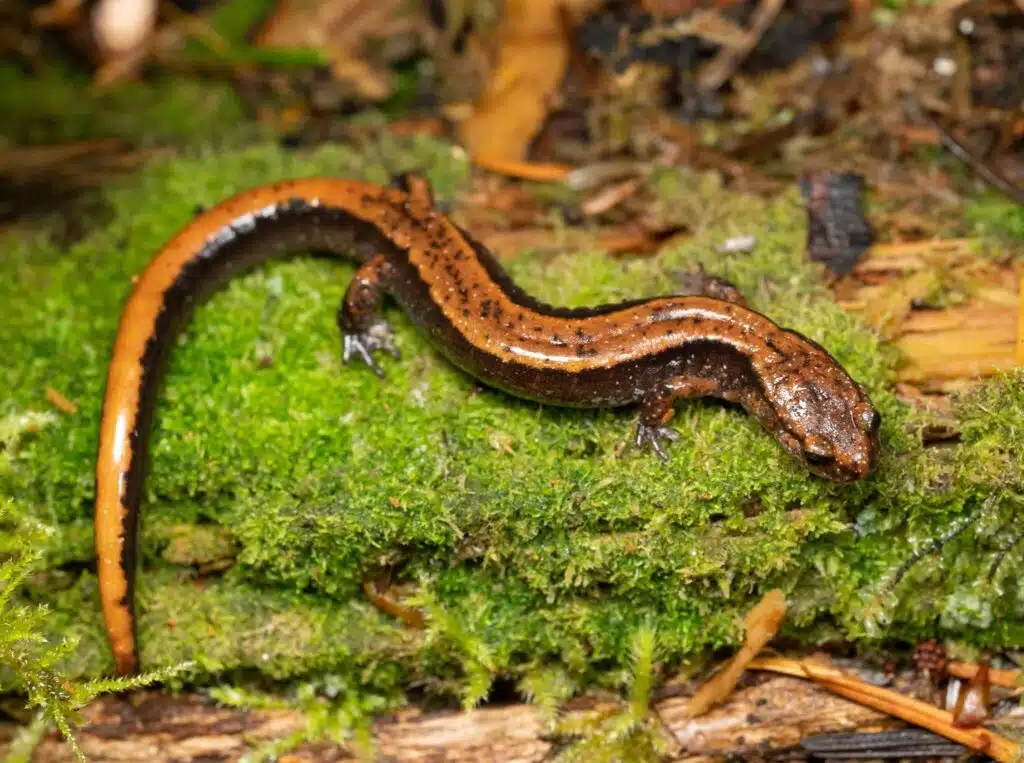
The Western Red-backed Salamander (Plethodon vehiculum) is one of the smallest species of salamander living in the Northeast US territories.
It likes the forests in the area together with the riparian streams and rocky terrains of the area, like many other species of salamander.
Western Red-backed Salamander is known for having a distinct band that runs from head to tail.
This band can have different colors which can sometimes confuse when identifying this species with other banded salamanders.
Its size is considerably smaller than the average size of North American salamander species. In the wild, it rarely grows more than 2 inches.
The Western Red-backed salamander is also known to have very short limbs compared to the rest of its body sie.
29. Western Slimy Salamander
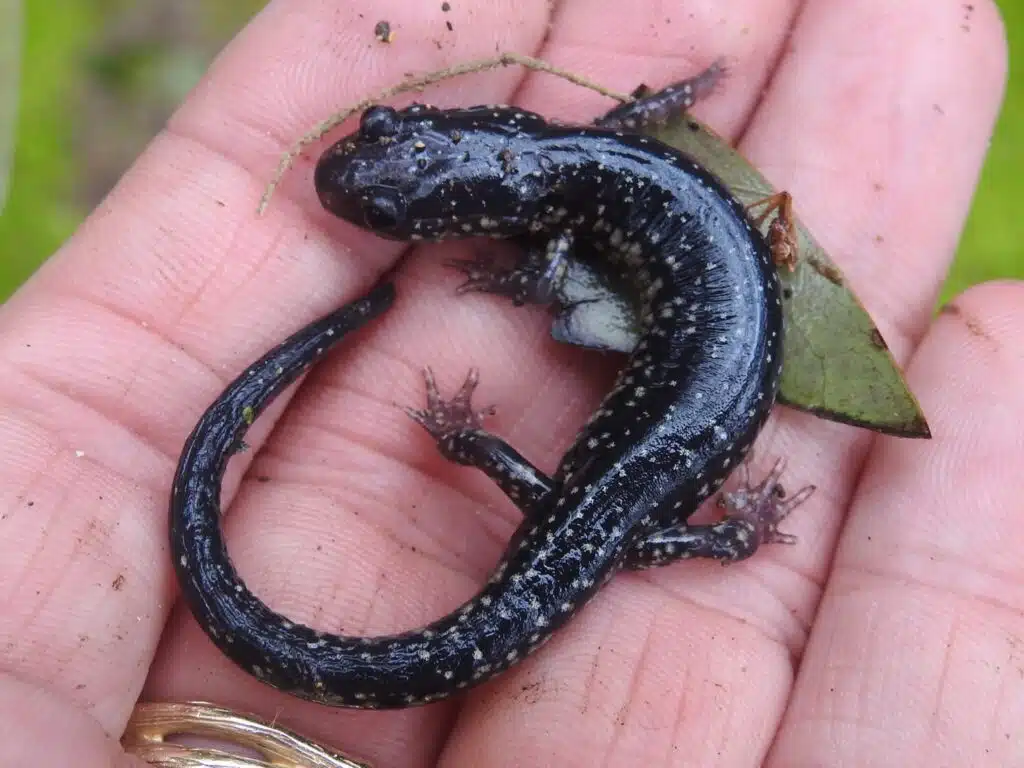
The Western Slimy Salamander (Plethodon albagula) gets its name from its slimy body. These salamanders release a sticky substance that might deter some predators.
The salamander is found in disjunct or displaced populations across the US. The salamanders in Texas exhibit the most curious habits as they don’t lay eggs in the water like most other endemic species.
Still, like all salamanders, the Western Slimy salamander prefers high humidity habitats.
30. White-spotted Slimy Salamander
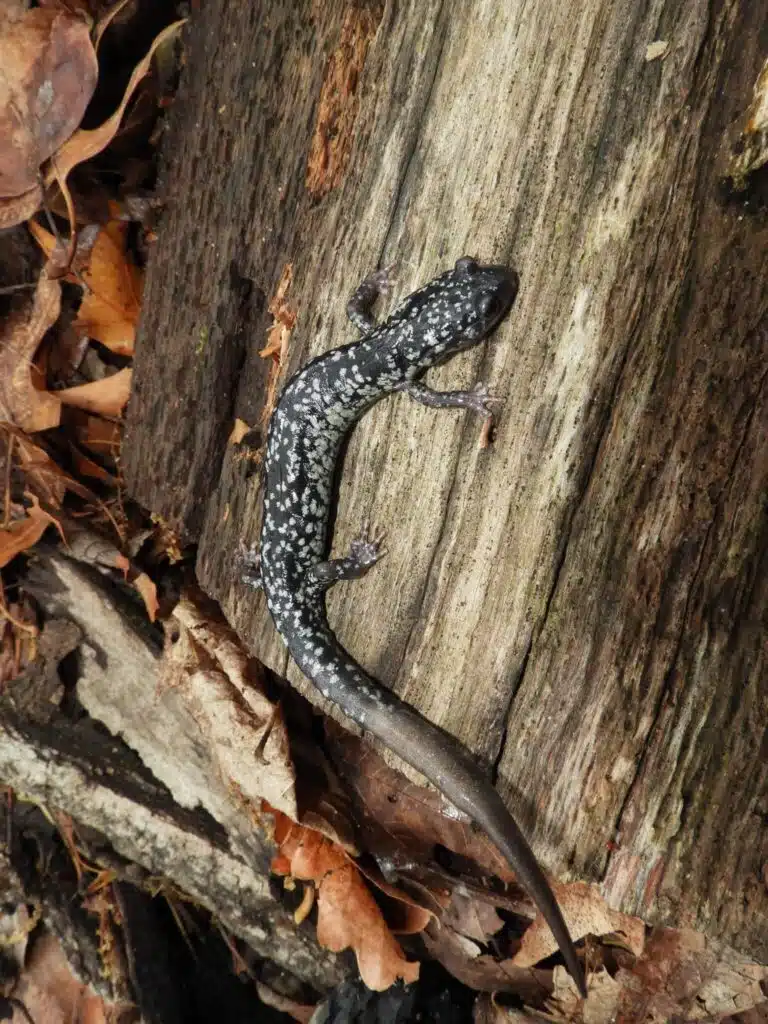
The White-spotted Slimy Salamander (Plethodon cylindraceus) is a species of dark color with small white spots across its body.
It prefers to live in hardwood forests where it feeds on the high humidity at ground level and below ground level.
Unlike many other salamander species, it doesn’t live under the ground-level leaves of hardwood forests but rather under large objects such as large rocks or large logs where a small cave-like habitat is recreated.
The species live a short life compared to most other US-based salamanders.
It might live up to 10 years in some parts of the country.
These slimy salamanders mate twice per year, once in the spring and once in the fall.
31. Northern Zigzag Salamander
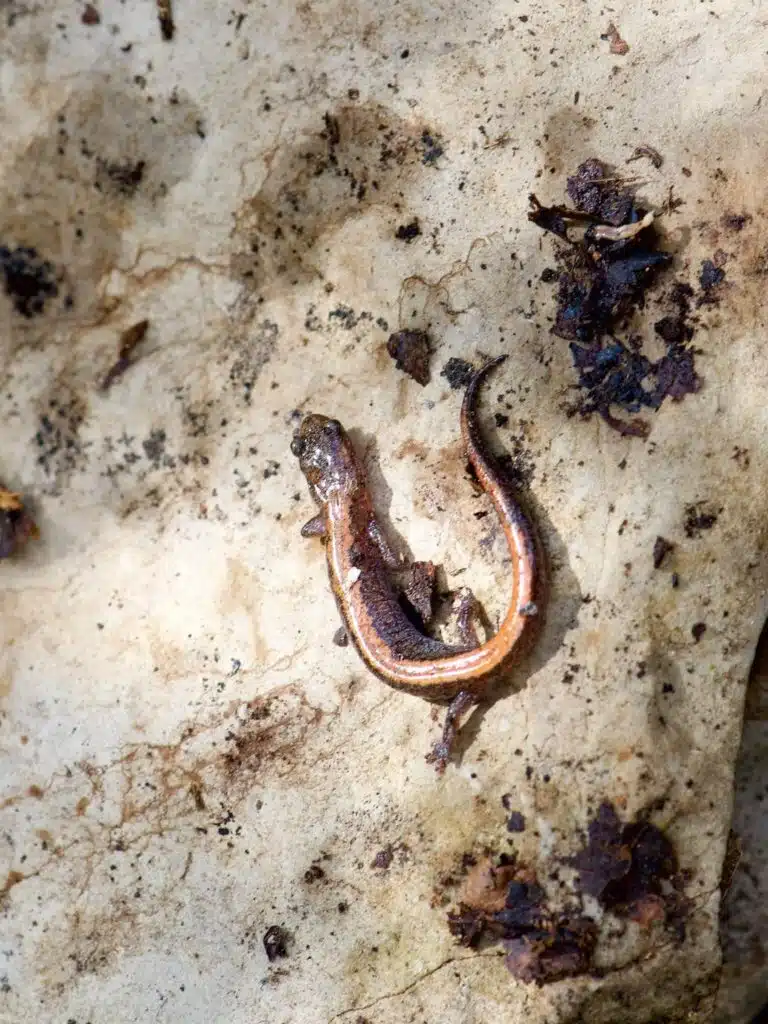
The Northern Zigzag Salamander (Plethodon dorsalis) is one of the polymorphic species found in the US. Identification can confuse as this species comes in multiple colors and patterns.
Its most common version has a dark color with a zigzag line that runs from its head to the tip of its tail.
The problem with identifying it by its zigzag line is that it comes in other colors such as brown without the line that runs from head to tail.
This is a small species that mostly grow up to 3.5 inches.
It feeds on a wide range of insects and spiders and it’s one of the most abundant types of salamander in the US.
Further Reading: